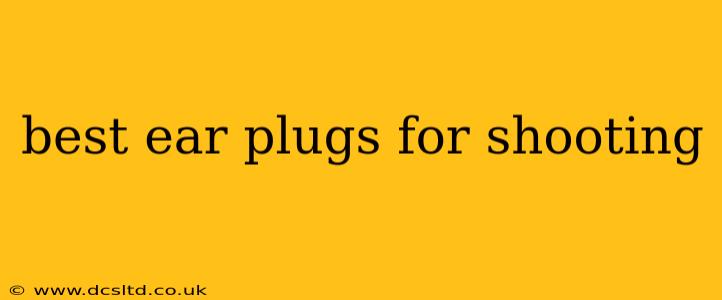Shooting sports are exhilarating, but the intense sounds can severely damage your hearing over time. Protecting your hearing isn't just a good idea; it's essential. Choosing the right earplugs is crucial for ensuring effective noise reduction without compromising your situational awareness. This guide explores the best earplugs for shooting, helping you find the perfect fit for your needs and budget.
What Makes Good Shooting Earplugs?
The ideal earplugs for shooting offer a balance of noise reduction and clarity. They should significantly attenuate the harmful high-intensity sounds of gunfire while still allowing you to hear important cues like range commands and conversations. Key factors to consider include:
- Noise Reduction Rating (NRR): This number indicates the amount of noise reduction the earplug provides. A higher NRR generally means better protection, but excessively high NRRs can muffle too much sound. For shooting, an NRR of 22-33 is often recommended.
- Comfort: You'll be wearing these for extended periods, so comfort is paramount. Ill-fitting earplugs can be uncomfortable and lead to poor noise reduction. Consider different styles (foam, silicone, custom-molded) to find what suits you best.
- Fit: A proper fit is essential for effective noise reduction. Earplugs that don't seal properly will let sound in, negating their purpose.
- Durability: You'll likely be using your earplugs repeatedly, so durability is important. Look for earplugs made from robust materials that can withstand regular use.
- Hygiene: Reusable earplugs need to be easy to clean to prevent infection and maintain hygiene.
What are the Different Types of Earplugs for Shooting?
Several types of earplugs are well-suited for shooting, each with its advantages and disadvantages:
Foam Earplugs:
- Pros: Affordable, readily available, effective noise reduction.
- Cons: Can be less comfortable than other options for extended wear, disposable.
Silicone Earplugs:
- Pros: Reusable, more comfortable and durable than foam, offer a good seal.
- Cons: Can be more expensive than foam earplugs.
Custom-Molded Earplugs:
- Pros: Superior comfort and fit, excellent noise reduction, custom-designed for your ears.
- Cons: More expensive than other types, require a professional impression.
How Much Noise Reduction Do I Need?
This is a crucial question! Excessive noise reduction can make it difficult to hear crucial range commands. The sweet spot usually falls within the NRR range of 22 to 33. Consider your shooting environment and the types of firearms you use when deciding on an appropriate NRR.
What is the Best Earplug Material?
There's no single "best" material, as it depends on individual preferences and needs. Foam earplugs are excellent for affordability and effectiveness, while silicone earplugs provide reusability and increased comfort. Custom-molded earplugs are considered the top tier for comfort and fit but come with a higher price tag.
Can I Use Regular Earplugs for Shooting?
While you can use regular earplugs, those designed specifically for shooting are generally recommended. Shooting earplugs are designed to offer optimal noise reduction while still allowing you to hear important ambient sounds. Using inadequate protection can lead to serious hearing damage.
How Often Should I Replace My Shooting Earplugs?
Foam earplugs are disposable and should be replaced after each use. Reusable silicone earplugs should be cleaned after each use and replaced when they show signs of wear and tear or significant degradation. Custom-molded earplugs have a longer lifespan, but they should still be inspected for damage and replaced as needed.
Choosing the Right Earplugs for Shooting: A Summary
Selecting the best earplugs for shooting depends on individual needs and preferences. Consider the NRR, comfort, fit, durability, and cost. Start by trying different types to find what works best for you and ensure you're adequately protecting your hearing on the range. Remember that prioritizing hearing protection is crucial for a long and enjoyable shooting career.
